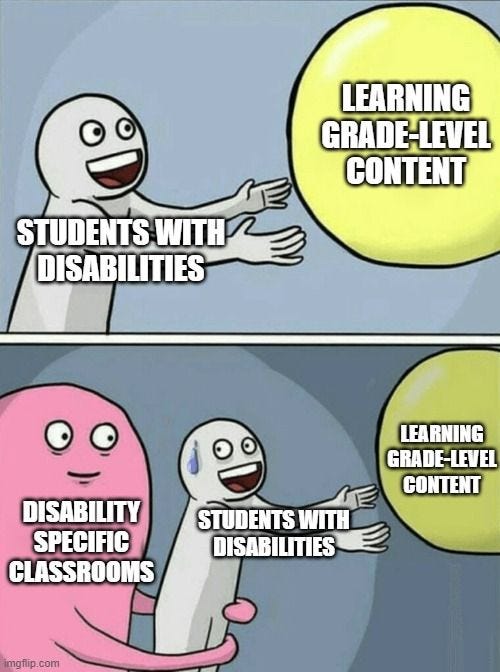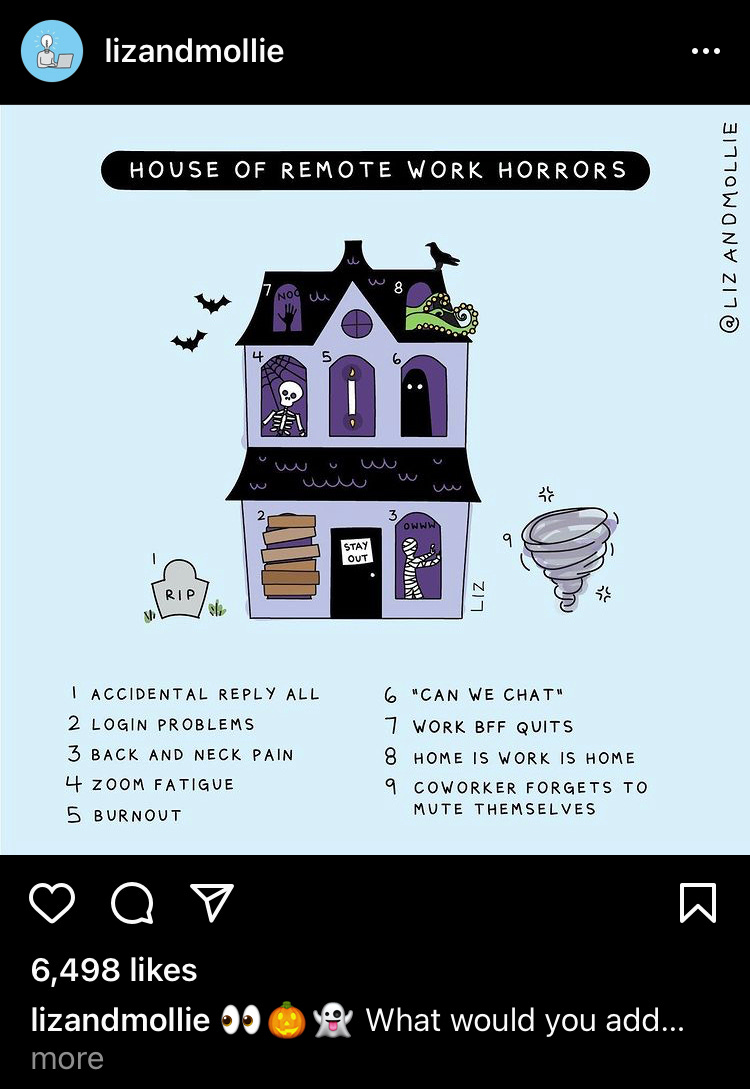Disability Specific Classrooms Hold Students Back
Why are inclusive memes the best? And do disability specific classrooms hold students with disabilities back from grade-level content?
What is it about memes that get everyone talking?
Last week we published a meme on the socials. Here it is.

There were of course the positive comments, as per usual.
Grade level content should always be the goal. And with the right modifications and accommodations is possible. - C.P.
Why are inclusive memes the best thing ever. - A.B.
Inclusive systems provide a better quality education for all children and are instrumental in changing discriminatory attitudes. Schools provide the context for a child's first relationship with the world outside their families, enabling the development of social relationships and interactions. - K.T.
Yuuuuuuuuup. - K.R.
But the not-so-positive comments are the ones that I want to respond to. Because people have some serious concerns about this idea that disability-specific classrooms hold back students with disabilities from learning grade-level content.
And I want to address those concerns!
Well Tim, why didn’t you just reply to their comment in the Facebook comment thread?
Because this is way more fun!
Let’s take this one first.
Grade level content may not be suitable for some individuals. - S.W.
Now, I think what they meant was that grade-level content may not be suitable if not given the right supports. I think even some teachers in disability-specific classrooms get this. For instance, when I taught in a segregated special education classroom for students with “severe and profound” intellectual disabilities, would I simply read a chapter out of the 5th-grade textbook and expect everyone to understand and retain it the same way? No, I differentiated my instruction—which is what we are trained to do as teachers.
I used visuals, we sang songs, we made models, we acted out plays, and we played games. All of these activities reinforced the grade-level content even if everyone didn’t comprehend it at the same level. This principle also works in a general education classroom. And I’ll get back to this later. But the idea that some learners should not be expected to learn grade-level content is setting the bar too low.
You’ve probably heard the term “the least dangerous assumption.” Jen & Mira from the Instagram account Teaching Is Intellectual just posted about this. Here is the idea: the least dangerous assumption about a student is that if they have poor educational performance, there is something wrong with the instruction, not that the student has deficits.
But Tim, what if I know for sure that my student isn’t getting it?
Here is the thing. Sometimes, we don’t actually know what the student is getting. But we won’t know unless we try.
How about this one?
Absolutely!
But impossible when teachers don’t have the support, training, experience or in many cases, personal traits and skill sets to modify the curriculum enough to teach in this way!
Then “meme’s” like this “explained” through a description, just make parents like me; who ended up pulling their kids out of mainstream AND disability specific education after experiencing both, to Homeschool against the Education Department’s set curriculum myself and successfully from years 7 to year 12, drives me CRAZY!
We all know the issues, talk about them, create meme’s and still the issues remain!
I wasn’t wasting another moment fighting a faulty system to make this happen, when the cost would be carried by my child for the rest of his life! If they couldn’t and wouldn’t do it, I would!
….and my child won!
Maybe a third hand could be included in this meme that depicts the parents that made a decision at this point and gave up much to do it themselves because their child deserved better and they weren’t prepared to wait for the system to be fixed… not another minute longer… - R.S.
First of all, kudos to this commenter for doing what they thought was right for their child. It sounds like it wasn’t an easy path, but it was the best path for them. And yes, our system is faulty, but you would be surprised at how many people know it is faulty and don’t do anything about it. I’m glad this commenter said they weren’t going to wait around any more. If you work in a school that continues to separate students by disability, we are here to show you that there is a better way. We want to stand with you as you speak up for more inclusive practices in your district. And if you want help or ideas on how to do that, my Zoom room is always open—well, you know what I mean.
Last one.
Our son participated in regular classes (with extensive support and extensive time out of class) but he never really truly was close to grade level content.
Once he hit high school it became impossible (though it was tried) to get him involved with grade level content.
For some children it is simply not an option.
That said, every child should be given as much support as possible to achieve this, with the understanding that proper accomodations be made for those who can not achieve it.
There is NO one size fits all solution. - C.B.
While it is hard to read emotion and tone in a Facebook comment, I get the sense that this commenter feels like all the effort that was put into making the curriculum accessible for their son failed. And so I guess I am very interested, do you think it was worth it? I completely agree with their last statement, that there is no one size fits all solution. Is having a flexible system that meets the needs of all students using different levels of support a one-size-fits-all solution? I don’t think so. I think that is the ideal that we are striving for.
I want to circle back to something I mentioned about expecting students to learn grade-level content and how it connects to the original meme. The meme’s message very simply is that disability-specific classrooms make it hard for students to learn grade-level content. I think that sentiment is universally true.
In segregated special education classrooms, there is often a packaged curriculum that is loosely based (or aligned) to grade-level standards. And if there isn’t, the curriculum is defined by the district or special education department. In these classrooms, there are often three or four grade levels present at one time. When I was in the classroom, it was Kindergarten through fifth grade. That means that teachers in these classrooms have to teach multiple grade levels of content across English Language Arts, Math, Science, and Social Studies.
In general education classrooms, how many grade levels are educators expected to teach. One, maybe two (if there is a combination class—do they even do that anymore?). Teachers often have a grade-level team where there is dedicated planning, common assessments, and use a curriculum pacing guide that they worked together in developing.
If we were really concerned about having students with significant disabilities learn grade-level content, why aren’t special education teachers (especially in those disability-specific classrooms) invited to be part of those teams? Why do they constantly feel left out of professional development that would help them understand the content they are supposed to teach?
Here is an idea. If you are an educator in one of these intellectual disability or autism classrooms and want to do something about this, ask to be part of the grade-level team and see what happens. Or if you are a school administrator, invite the teacher of the autism classroom to be involved with grade-level teams. You may not be able to dismantle segregated classrooms in your school or district, but we can start breaking down the barriers to the curriculum. And to me, that is still progress.
One more thing. In the comments, Sarah Taylor posted an article she wrote for Chalkbeat called, “My son has intellectual disabilities. He deserves a rich and challenging curriculum.” Make sure you check it out.
She talks about the decision to move her son from public to private school because her middle school son and classmates with intellectual disabilities were not permitted to take science classes, were denied access to chapter books, told not to complete the elective preference form that general education students were given, and spent most of their time in physical education class picking up trash around the school.
In the article, Sarah says that she is grateful that her son is learning and thriving now but disappointed that they had to leave their public school for him to learn grade-level content.
I can’t tell you how happy seeing engagement on our posts makes me feel. Let’s keep the conversation going about authentic inclusive education and how to change the educational system to get there!
Have a great week!
Tim
ICYMI
Adaptive Costumes Make This Halloween More Inclusive
5 Ways to Move Beyond Down Syndrome Awareness
[Podcast] Michael McSheehan | How MTSS and UDL Fit Into Inclusive Education
[Podcast] Jenna Rufo | Using Inclusion as a Framework to Build Equity and Inclusion for All Students
In The News
Disney Implementing Changes To Disability Access At Theme Parks
Federal Jobs Program Moves To End Subminimum Wage
Importance of inclusion and integration for students with disabilities
What I’m Reading

What I’m Watching
What I’m Listening To
What’s in my Timeline

From the Wayback Machine
Why Horror Attractions like Pennhurst Hurt People with Disabilities
Just Because


